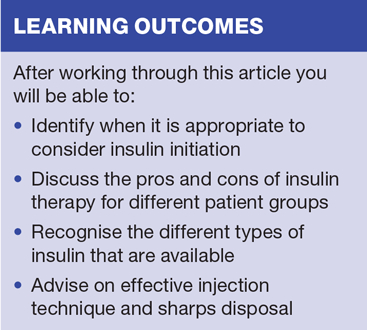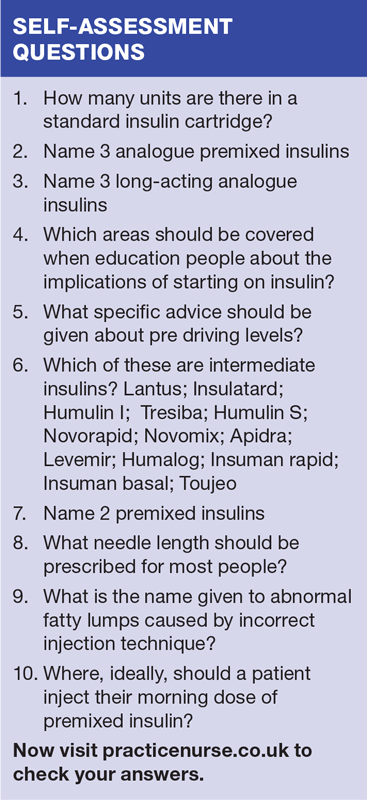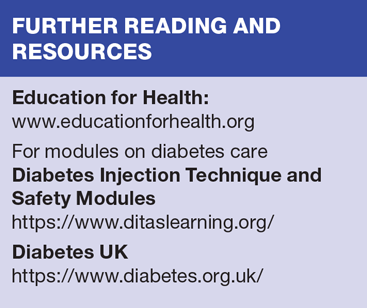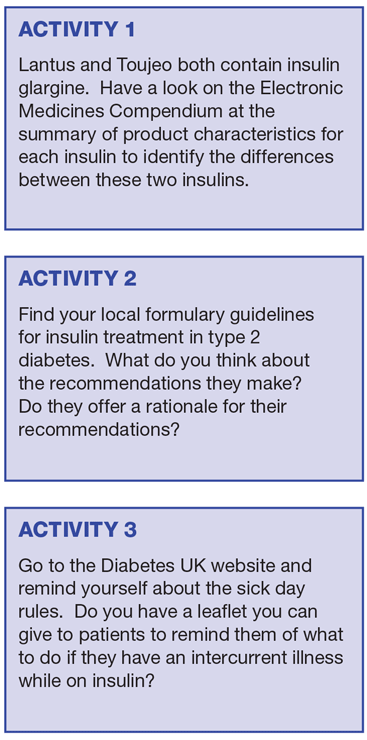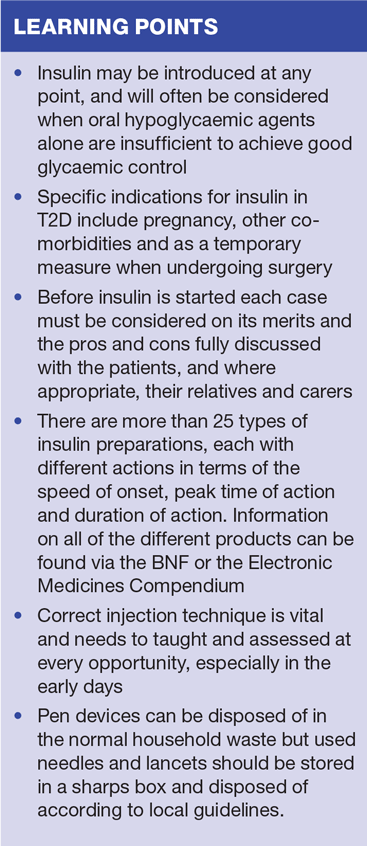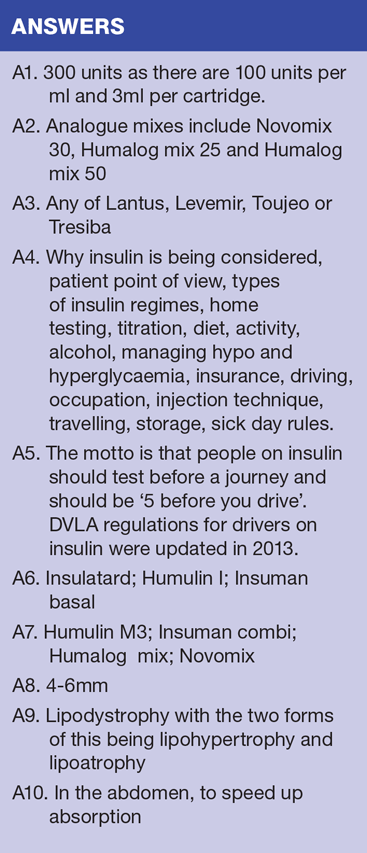Insulin initiation in type 2 diabetes — a guide for general practice nurses
Beverley Bostock-Cox
Beverley Bostock-Cox
RGN, MSc, QN
Nurse Practitioner Moreton in Marsh
Education Lead Education for Health, Warwick
General practice nurses have a key role in helping people with type 2 diabetes manage their condition. Insulin initiation can, with training and assessment of competence, become another important role in helping patients optimise their long term outcomes and reduce the risk of complications. Read the article and then test your knowledge by completing the self-assessment questions. Then scroll down to check your answers.
The treatment of type 2 diabetes (T2D) involves lifestyle interventions along with pharmacological approaches aimed at improving glycaemic control, lipid profile and blood pressure. The ultimate aim is to optimise long term outcomes and reduce the risk of vascular complications. General practice nurses (GPNs) have an important role to play in all of these areas and play a key part in helping people with T2D to self-manage their condition. In this article we discuss the role of GPNs in initiating and titrating insulin in people with T2D.
It is important to note that insulin related errors have significant costs to the patient and to the NHS, and that no one should initiate, administer or titrate insulin doses unless competent to do so. Many localities provide access to education on insulin initiation for those GPNs who wish to offer this service, and online courses are also available to help people understand the subject better. An excellent example of an online course is the Six Steps to Insulin Safety created by the Primary Care Diabetes Society and TREND UK. This is free to access at http://www.cpd.diabetesonthenet.com/. However, completion of this course does not equate to competency in insulin initiation, something that the authors of the course are themselves keen to point out.
WHO SHOULD START ON INSULIN?
Insulin may be introduced at any point, from diagnosis of T2D through the years post-diagnosis, and will often be considered when oral hypoglycaemic agents alone are insufficient to achieve good glycaemic control (HbA1c between 48-58mmol/mol).1 Sometimes there are specific indications such as pregnancy,2 at other times it may be patient preference or co-morbidities such as acute myocardial infarction.3 It may also be initiated as a temporary measure e.g. when undergoing surgery.
PROS AND CONS OF STARTING ON INSULIN
Each case should be considered on its merits and insulin should only be started once a full discussion has been had with the patient (and potentially their carers) about the benefits and drawbacks of insulin use. In general, younger people may find it easier to adapt to a lifestyle that includes insulin injections, but this does not mean that older people should not be offered insulin where appropriate.
However, another consideration should be the length of time since diagnosis. There is evidence to suggest that the further down the line an individual is with their diabetes, the less influence glycaemic control has on their long-term outcomes and the more important blood pressure and lipid management become.4 It is therefore important to weigh up the presence of any symptoms (particularly osmotic symptoms such as thirst and polyuria), the patient’s age, and time since diagnosis, co-morbidities, lifestyle, social circumstances (e.g. living alone), cognitive abilities and dexterity before deciding that insulin is the answer to poor glycaemic control.
Insulin can be useful when the pancreas is no longer able to supply enough insulin for the body’s needs. It is a naturally occurring hormone but the manufactured delivery systems currently available do not replicate the way the body would regulate insulin in normal physiology. As a result, the main drawback of insulin therapy is hypoglycaemia. Treatment with insulin injections may also increase the risk of weight gain, which is something most people with T2D will be trying to avoid. It is important, then, to consider whether other therapeutic options might be preferable and to address any other opportunities to optimise non-insulin therapies, such as SGLT2 inhibitors or GLP1 mimetics before introducing insulin.5 That said, if the pancreas is simply unable to deliver the body’s insulin requirements then insulin replacement therapy will need to be commenced.
EDUCATION ABOUT INSULIN
Many patients will have been dreading starting on insulin and you can offer understanding and support with regard to these feelings. Many GPNs say that people starting on insulin find it much easier than they anticipated and will often feel much better once their glycaemic control improves. It is worth sharing these observations with people who are considering the need for insulin therapy and addressing any myths they may have heard.6
Before starting insulin, patients should be fully aware of the lifestyle implications. For example, they may need to pay closer attention to when and what they eat and the type and frequency of physical activity. They may not have been carrying out regular home blood glucose monitoring (HBGM) and need to understand that they are likely to need to do this from now on. They need to understand how to manage episodes of hyperglycaemia and hypoglycaemia and how to adjust their regimes accordingly. They also need to be aware of managing intercurrent illness – the so-called sick day rules.7 For these reasons you should allow at least an hour for the first appointment and plenty of time for subsequent appointments, with the opportunity for telephone contact in between.
Rushing through the education element will be counterproductive and it is likely to increase anxiety if people feel unsupported and ill at ease when starting on insulin. Patients should also be aware of their responsibilities with regard to insurance, driving (‘5 before you drive’)* and possible restrictions with regard to some occupations, although the law prohibits discrimination against people with diabetes.
WHICH INSULIN?
There are more than 25 types of insulin preparations on the market, and each insulin has different actions in terms of the speed of onset, peak time of action and duration of action. (OPD) Information on all of the different products can be found via the BNF or the Electronic Medicines Compendium. Every time a GPN has a consultation with a patient on insulin the OPD – onset, peak, duration – aspects of the insulin/s they are injecting should be borne in mind when tailoring treatment to each individual.
As with many other therapy options, the simpler the regimen, the more likely people are to adhere to the treatment. For people with T2D, a once or twice daily injection will be enough to improve glycaemic control whilst minimising disruption to their day to day life and reducing the risk of hypoglycaemia.8 The most common types of insulin are the U100 insulins i.e. there are 100 units/ml. There are human insulins and analogue insulins; the latter group have been genetically modified to be longer acting than human insulins or, in the case of the rapid acting analogues, more rapid acting than human insulins.
When choosing the most appropriate insulin for someone with T2D, once daily injections with a long acting analogue insulin (often Lantus or Levemir but sometimes Toujeo or Tresiba) provide a ‘drip feed’ of background insulin and may be preferred by many patients. The ‘OPD’ of long acting analogues is onset at 0-2 hours, no peak and duration of 18-42 hours. Basal insulins are normally given once daily, although some may be given twice daily if that works better for the patient and the insulin is licensed to be given this way.
Local guidelines may encourage the use of twice daily intermediate acting insulins such as Humulin I, Insulatard or Insuman basal. The OPD of these insulins is onset at 2-4 hours, peak at 4-8hours and duration of 14-16 hours. Premixed insulins are usually given twice daily with breakfast and the evening meal. Premixed analogues contain a mix of rapid acting and long acting insulin, whereas premixed human insulins contain short acting and intermediate acting insulins. Analogue mixes include Novomix 30, Humalog mix 25 and Humalog mix 50, and the human mixes include Humulin M3 and Insuman Comb 15, 25 or 50. The numbers refer to the percentage of short to intermediate acting insulins, so Insuman Comb 25 has 25% short acting and 75% intermediate acting insulin.
As in other therapy areas, it is worth discussing the options with each individual to see what they prefer. Premixed analogues will begin to act more quickly than the human insulins so should be injected just before, or even after eating. Premixed human insulins should be given 15-30 minutes before a meal to allow for their slower onset of action.
Insulin can be stored in the fridge until it is needed and can then be left out at normal room temperature for approximately a month. Care should be taken in extremes of weather or when travelling abroad regarding storage of insulin.
Whatever decision is made about the insulin regimen, it is always possible to change to a different regimen in the future if the current one is not working for that patient.
CHOOSING DEVICES AND NEEDLES
Nowadays most insulin is delivered through pen devices. The maximum number of units that can be dialled up varies from device to device. Dose increment markings also vary from 0.5 units to 2 units, allowing very precise tailoring of doses to be achieved. However, it is easy to see how mistakes might happen if healthcare workers are not familiar with the insulin, device or patient when giving an insulin injection.
Some people prefer pens with replaceable cartridges but, in this case the pen device and insulin cartridges must be compatible for use together. Cartridges are prescribed in packs of 5 with 100 units/ml and 3ml per pen. In some areas syringes and needles are still used but there is greater potential for needlestick injury with this option.
Whichever device is used, smaller needles are appropriate for almost all people. Anything from 4-6mm should be used, as a bigger needle increases the risk of an intramuscular injection, leading to variable absorption, increased risk of poor control, more frequent episodes of hypoglycaemia and lipodystrophy.9 Issues with dexterity and visual impairment should always be considered when patients are starting on insulin.
INJECTION TECHNIQUE
The 2015 updated Forum for Injection Technique guidelines provide a reminder of the importance of correct injection technique and should be studied carefully.9 Incorrect technique, whether through failure to use the right needles, forgetting to change needles for every injection, omitting to rotate sites or a myriad of other possible errors can have devastating consequences.
Possible injection sites include:
- Thighs and buttocks – best for intermediate insulins or evening doses of premixed insulins due to slower absorption rates reducing the risk of a nocturnal hypo
- Abdomen – good for the morning dose of premixed insulin due to faster absorption rates from this site in preparation for the post prandial rise after breakfast
- Arms – may also be used.
Correct injection technique is absolutely essential and this should be taught and assessed at every opportunity, especially in the early days.
A SIMPLE INSULIN START
A once or twice daily regimen should be considered in T2D.8 For many, a once daily injection of a long-acting analogue insulin will be the simplest way of starting on insulin. Insulin levemir or glargine may be started at a dose of just 10 units to allow people to get used to injecting. HBGM tests carried out first thing in the morning before any food or activity will indicate the level of control that is being achieved with this dose and the aim is to get this reading to below 7mmol, but not lower than 4mmols. If this is not achieved after 3 days, the dose can be increased by 1-2 units until it is.
This gentle approach, using a long-acting basal insulin may help to increase the patient’s confidence and help them to see the beneficial effects of being on insulin while at the same time keeping the risk of hypoglycaemia low. After 3 months an HbA1c reading will indicate whether overall glycaemic control has improved.
If early morning readings have remained between 4-7mmol but the HbA1c is still raised, consideration should be given to a different regimen, perhaps using a pre-prandial rapid acting insulin where appropriate, as defined by the patient’s HBGM test results.10 Patients on insulin should be provided with an ‘insulin passport’, which provides a record of their insulin treatment along with sections on the safe use of insulin and emergency information.8
SHARPS SAFETY
Pens can be disposed of in the normal household waste but used needles and lancets should be stored in a sharps box.9 Different local authorities will have their own arrangements in place for collection of sharps boxes and you will need to be familiar with yours.
OTHER THERAPIES
Insulin is often used in conjunction with oral hypoglycaemic agents or other injectable therapies – i.e. the GLP1s. When deciding if other treatments should be stopped or continued, consideration should be given to the licensed indications for each treatment and also the risk of hypoglycaemia. For example, using insulin and sulfonylureas together may increase the risk of both hypos and weight gain as each treatment has these side effects when used alone, never mind together; using pioglitazone with insulin is also known to increase the risk of heart failure.1 For people who are already taking one injectable the other may be introduced via a new product, Xultophy – which combines a GLP1 and insulin in one once daily injection.11
FOLLOW UP
People with diabetes need holistic care that recognises the stress and burnout that accompanies the condition at times. Management of the condition involves offering compassionate care and encompasses an understanding of the anger, fear and resentment that may make the condition harder to treat. A sympathetic nurse who can offer time to explain all of the issues that surround insulin initiation will be appreciated by most patients, and their families or carers, who may also be feeling anxious and overwhelmed by the responsibilities that insulin therapy entails.
Regular follow up should be offered and may include telephone consultations as well as face-to-face appointments. Injection sites should be inspected frequently at first but should continue to be checked even after insulin therapy is established. People should understand the importance of bringing their HBGM readings along to the consultations so patterns can be assessed and insulin titrated accordingly. The focus, however, should remain on the individual, not just the readings.
CONCLUSION
In summary, insulin initiation may be appropriate for people who have poor glycaemic control and/or osmotic symptoms, but consideration should be given to the benefits and drawbacks for each individual. The patient’s own views are important too.
There are many types of insulin, devices and needles and it is vital to choose the most appropriate regimen for that person. In many cases a once or twice daily option will be both suitable and preferable to more frequent daily injections.
Correct injection technique is central to the effectiveness of insulin therapy and should be taught, assessed and monitored throughout the patient’s life. All GPNs have a role to play in supporting people on insulin at the start of treatment and beyond. However, insulin therapy is a high risk area in terms of the potential for errors so GPNs should be trained and competent to work in this area.
REFERENCES
1. NICE. Type 2 diabetes in adults: management. 2015
2. NICE. Diabetes in pregnancy. 2015
3. Malmberg K, Norhammar A, Wedel H, Rydén L. Glycometabolic state at admission: important risk marker of mortality in conventionally treated patients with diabetes mellitus and acute myocardial infarction: long-term results from the Diabetes and Insulin-Glucose Infusion in Acute Myocardial Infarction (DIGAMI) study. Circulation 1999; 99:2626.
4. Mannucci E, Dicembrini I, Lauria A, Pozzilli P. Is Glucose Control Important for Prevention of Cardiovascular Disease in Diabetes? Diabetes Care 2013; 36 (Supplement 2): S259-S263
5. Inzucchi SE, Bergenstal RM, Buse JB, et al. Management of Hyperglycemia in Type 2 Diabetes. Diabetes Care 2015;38(1):140-9 http://care.diabetesjournals.org/content/38/1/140
6. American Diabetes Association. Insulin myths and facts, 2007. http://clinical.diabetesjournals.org/content/25/1/39
7. Diabetes UK. Dealing with illness. 2016 https://www.diabetes.org.uk/Guide-to-diabetes/Living_with_diabetes/Illness/
8. NICE Clinical Knowledge Summaries. Insulin therapy in type 2 diabetes. 2016 http://cks.nice.org.uk/insulin-therapy-in-type-2-diabetes
9. Forum for Injection Technique. 2015 http://www.fit4diabetes.com/
10. Royal College of Nursing. Starting injectable treatment in adults with type 2 diabetes. 2012 https://www2.rcn.org.uk/__data/assets/pdf_file/0009/78606/002254.pdf
11. NICE. Type 2 diabetes: insulin degludec/liraglutide (Xultophy). 2015 https://www.nice.org.uk/advice/esnm60/chapter/Full-evidence-summary
Related articles
View all Articles
